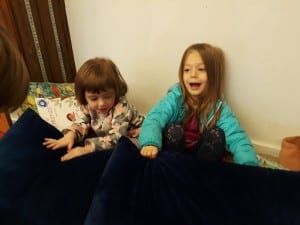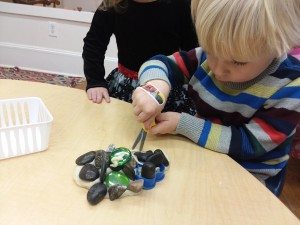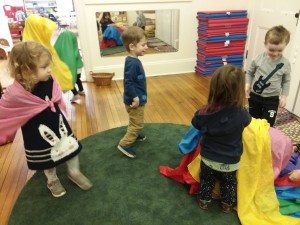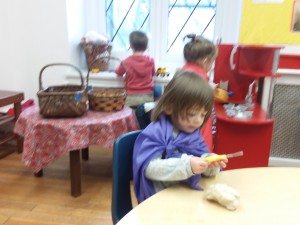“What Do We Do With the Mad That We Feel?”
Questions and Reflections From a Veteran Pre School Teacher
How do we help our children feel safe?
How do we help them understand their feelings?
How do we show and express our confidence in their ability to be kind?
How do we model compassion?
Each day across the land, preschool teachers and parents of young children struggle with these questions. In light of current events, even those of us who have been at this for a long time feel as though we are still wrestling with these questions.
A parent recently reminded me that Fred Rogers had some relevant insights about what children see on screens. In the wake of the recent horrific events in Pittsburgh and Louisville, and the fires in California, and inspired by a classroom filled with Superheroes on Halloween to reflect — on children, violence, and “saving the day,” I offer these reflections.
In our classroom this autumn, there was an explosion of Power Ranger play. Since this consisted mainly of weapons, large sudden movements, and fighting, I paused the play, and asked some of the children some questions. This led to great conversations and artwork among a few of the children, regarding both Power Rangers and a Big Foot monster, who had also entered their play.
One thing that really struck me was that the only thing the children were able to tell me about Power Rangers, aside from their different colors, is that “they fight.” Or, “they fight bad guys.” The term “bad guys,” seems to mean simply, the “others,” the “not us.” At this point, that is their take-away from whatever they are watching on screens. So that is what they are bringing to their classmates who have never seen shows with fighting.
Superheroes and “bad guy” play are not new, nor is violence in our country. In my kindergarten classrooms decades ago, alongside children who had parents deployed in the Gulf War, or in jail for violent crimes, I was dealing with Power Rangers. To be honest, it’s a challenge to have certain TV characters infused into our classroom of 3 and 4 year olds. It is even harder now than it was 25 years ago, because screens, and hence the graphic images of fighting that the children see, have become both larger, and smaller and portable, and more prevalent. Images of both real-life and make-believe violence — in our living rooms, in cars, even in children’s bedrooms — live side by side on these screens.
Although in our classroom the Power Ranger play has dissipated somewhat, it’s still there. The “Monster” play continues, and is particularly frightening for some of the students. A couple of my older students have learned to say, “it’s just pretend.” But for these same four year olds, and certainly for three year olds, pretend monsters — as well as teeth-baring fictional wolves, an angry-looking witch, or any one of a number of images that might be marketed for young children – can and do feel extremely threatening. Distinguishing between pretend and real is a complicated process, and does not even evolve along a predictable continuum. One minute, monster play can elicit shrieks of joy from a child; the next minute, the same child is running into my arms for comfort. In the light of day, monsters stimulate laughter; when darkness falls, tears.
Imaginative play is the work of young children, and for our three and four year olds, it is an exciting and constantly evolving and developing exploration. It grows their brains, builds social skills, and leads to joy and excitement, frustration and fear. In a group of 16 young children, we can see all of these emotions simultaneously. As teachers, we constantly scan and monitor, join and guide.
Getting the children to pause their play, and talk and paint about it, was just my initial response. I imagine in the future we might be having conversations in our classroom about different kinds of power — about being strong and capable, and about distinguishing between superpowers and real powers. We have started to have conversations about the FEELINGS we have — feelings that might cause us to hurt others, or to help others. And we will always have sand and art materials available for them to express, play out, and record their feelings.
Mr. Rogers points out that when bad things happen and when people are hurt, it is reassuring to “look for the helpers.” We want to teach the children that WE can BE the helpers, and that fighting and hurting others is not helpful; that it is, in fact, harmful. Even when others are not hurt, we can always practice being helpful. It is possible to develop our “helping” powers.
I offer a few videos. I hope you might spend a few minutes watching them. If nothing else, Mr. Rogers reminds us that being present with young children, and available to listen and talk about what they are feeling, as well as what they might be seeing on screens, is so important. Even though some of these clips are from decades ago — before ipads, smartphones, enormous HD TV’s, and the current hate crimes — I think he is also a good reminder to limit and very carefully control our children’s exposure to screens.
The questions will always be there. So will our love for our young children.
https://www.youtube.com/watch?v=F9E-I7yBwIc
https://www.youtube.com/watch?v=FVNY2oPP2WI




